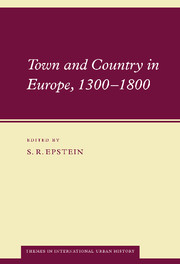Book contents
- Frontmatter
- Contents
- List of figures
- List of tables
- Notes on the contributors
- 1 Introduction. Town and country in Europe, 1300–1800
- 2 Town and country in Sweden, 1450–1650
- 3 Town and country in Holland, 1300–1550
- 4 Town and country in the Dutch Republic, 1550–1800
- 5 Town and country in England, 1300–1570
- 6 Town and country in England, 1570–1750
- 7 Town and country in the Polish Commonwealth, 1350–1650
- 8 Town and country in the Austrian and Czech lands, 1450–1800
- 9 Town and country in Germany, 1350–1600
- 10 Town and country in Switzerland, 1450–1750
- 11 Town and country in France, 1550–1750
- 12 Town and country in Castile, 1400–1650
- 13 Town and country in central and northern Italy, 1400–1800
- 14 Town and country in the kingdom of Naples, 1500–1800
- Index
3 - Town and country in Holland, 1300–1550
Published online by Cambridge University Press: 09 November 2009
- Frontmatter
- Contents
- List of figures
- List of tables
- Notes on the contributors
- 1 Introduction. Town and country in Europe, 1300–1800
- 2 Town and country in Sweden, 1450–1650
- 3 Town and country in Holland, 1300–1550
- 4 Town and country in the Dutch Republic, 1550–1800
- 5 Town and country in England, 1300–1570
- 6 Town and country in England, 1570–1750
- 7 Town and country in the Polish Commonwealth, 1350–1650
- 8 Town and country in the Austrian and Czech lands, 1450–1800
- 9 Town and country in Germany, 1350–1600
- 10 Town and country in Switzerland, 1450–1750
- 11 Town and country in France, 1550–1750
- 12 Town and country in Castile, 1400–1650
- 13 Town and country in central and northern Italy, 1400–1800
- 14 Town and country in the kingdom of Naples, 1500–1800
- Index
Summary
Introduction
Although it is easy to see retrospectively that the foundations for the state that came to be known as the Dutch Republic were laid during the late middle ages, as late as 1550 no one could have imagined its coming into being, let alone predicted its territorial composition and boundaries. Until the 1540s the driving force of state formation had been the conscious assemblage of principalities in the area of the Low Countries by the dukes of Burgundy and their successors, the Habsburg emperors of Germany. The process began with Philip the Bold entering into possession of the County of Flanders in 1384, and it ended with the submission of the duchy of Guelders to Charles V in 1543. The County of Holland that is the subject of this chapter was added to the Burgundian multiple state in 1428, when Duke Philip the Good successfully intervened in the protracted civil war between Jacqueline and John of Bavaria, the German house that had ruled Holland from 1349.
The focus on the County of Holland, which was only one of the seven provinces later to constitute the Dutch Republic, suffers to some extent from a retrospective bias. In the Republic's Golden Age, Holland's demographic, economic and political preponderance was overwhelming. In 1622 more than 40 per cent of the Republic's population lived in Holland alone. Regional patterns of urbanisation were even more skewed.
- Type
- Chapter
- Information
- Town and Country in Europe, 1300–1800 , pp. 54 - 79Publisher: Cambridge University PressPrint publication year: 2001
- 5
- Cited by



